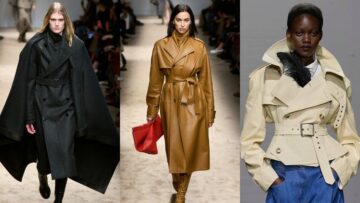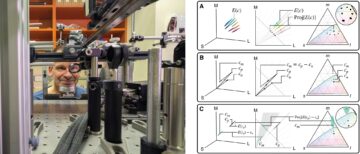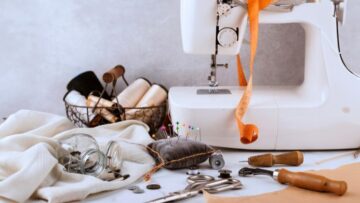Gone are the days of simple side seams, basic patterns, and lots of embroidery to embellish the surface. As fashion becomes more commercial and price-sensitive, patterns are being experimented, and surfaces are being toned down to reduce the cost of heavy embroidery, with more concentration on the creative mix ’n match of fabric textures. Lots of panels joining together to make a single garment is the new key to not being different but also getting the most raging trend of colour blocking right, with retailers and designers alike. But amongst all this the perfect way to add value to a garment is with the popularizing technology of decorative stitches that are rapidly being picked up as highlights not only on prints but also as subtle yet trendy decorations along the necklines, hemlines, cuffs, armholes and yokes…
Not only in fashion, but even a simple cotton bed sheet available at a department store might cost $ 25 – $ 30. But add a line of decorative stitching along the edge, and it looks like the $ 99+ set that came out of a fancy catalog. Similarly, a decorative topstitch on a coat or dress or a ornamented hemming at the edge of ladies top, is today a considerable source of value addition to a garment without struggling with beads, sequins, or other value add-on items. As important as it is to make a nice straight seam to mark quality in a garment, equally important in such turbulent times is increasing the aesthetic value of the garment through alternative but cheaper value add options like decorative stitches, which can be done in a regular sewing machine and all that an operator has to do is to just push the treadle and out comes swirls, leaves or diamonds in a row.
Decorating the Runways…
[bleft]A decorative topstitch on a coat or dress or a ornamented hemming at the edge of ladies top, is today a considerable source of value addition to a garment without struggling with beads, sequins, or other value add-on items. All an operator has to do is to just push the treadle and out comes swirls, leaves or diamonds in a row. [/bleft]
Spotted on the international runways are a fleet of high-fashion designers picking up the lead to make their collections unique with some most commercial looking decorative stitches. While famous names like Proenza Schoule and Derek Lam have used variations of the zigzag stitch, Fagoting stitch and the chevron stitch to join various panels of the ensemble adding an ornamental visual appeal over a number of straight seams, Rodarte has used the fly/feather stitch instead of the simple running stitch to hold a patch in place and in turn adding an embroidered value to the entire look.
The satin stitch which is often used as a filling stitch can be easily used to imitate the look of heavy embroidery as seen in the collection of Thakoon with an advantage of being achieved with simple sewing, bringing down the cost considerably. Fringing used by endless designers like Ralph Lauren, Altuzarra, and Donna Karan, has also one of the most easiest to achieve technique through the concept of decorative stitches, adding a variety of fringes on the hems of between panels in mere seconds through a machine. Commonly found on the edges of trend coats in contrasting colours the best of all stitches the blanket stitch seen in the classic collection of Heritage Cotton, and also the saddle stitch and the over-edge stitch which is the most basic yet trendy on the runways of Lauren for its leather accessories like belts and bags, incorporated the best in contrasting colour threads.
Following the trail very soon will be high street and mass retailers using the wide range of sewing machines available for decorative stitches to add a similar value to their ready-to-wear designs. Easily found as a one-time investment, while the basic machines traditionally offer just basic stitches, like a zigzag and satin stitch, the advanced machines such as Pfaff Creative 2170, Bernina 950, Janome 712 T which can also make buttonholes, and Kansai Mac 100, often include stitch packages of 20-40 decorative options. The most popularly applied in the current times are the following stitch types that will soon be a ‘must have’ value with every manufacturer…
[tabs_container style=”style1″ maincolor=”#000000″ overcolor=”#dd3333″]
[tab title=”Zigzag Stitch “]
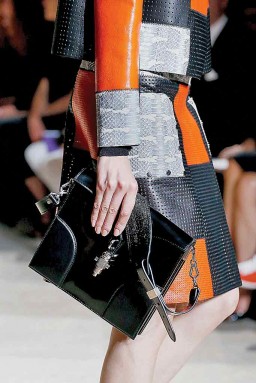 A zigzag stitch is a variant geometry of the lockstitch. Traditionally a back-and-forth stitch used where a straight stitch will not suffice. But today being the most commonly used decorative stitch, zigzag in variation of widths is used to replace the boring running stitch to attach two fabrics or a trim to a fabric in fashion today. Commonly used on the yokes, hems, cuffs and necklines, and for patchwork, smocking, to attach a trim or as a design element.[/tab]
A zigzag stitch is a variant geometry of the lockstitch. Traditionally a back-and-forth stitch used where a straight stitch will not suffice. But today being the most commonly used decorative stitch, zigzag in variation of widths is used to replace the boring running stitch to attach two fabrics or a trim to a fabric in fashion today. Commonly used on the yokes, hems, cuffs and necklines, and for patchwork, smocking, to attach a trim or as a design element.[/tab]
[tab title=”Chevron Stitch”]
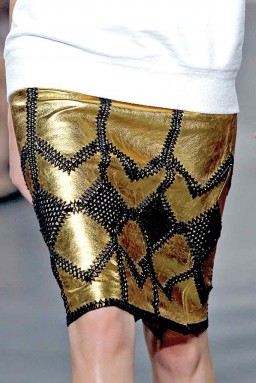 The herringbone stitch, with its most popular variation of the Chevron stitch, is often used to work in decorating borders and to accent the patchwork in crazy quilting, made up of a zigzag line, only the diagonal stitches don’t cross over each other, and each peak sports a little straight stitch “cap” at its tip. Used to join patches this stitch type is the most commercial looking stitch of all which looks fancy in contrasting colours and varying thread types. [/tab]
The herringbone stitch, with its most popular variation of the Chevron stitch, is often used to work in decorating borders and to accent the patchwork in crazy quilting, made up of a zigzag line, only the diagonal stitches don’t cross over each other, and each peak sports a little straight stitch “cap” at its tip. Used to join patches this stitch type is the most commercial looking stitch of all which looks fancy in contrasting colours and varying thread types. [/tab]
[tab title=”Blanket Stitch”]
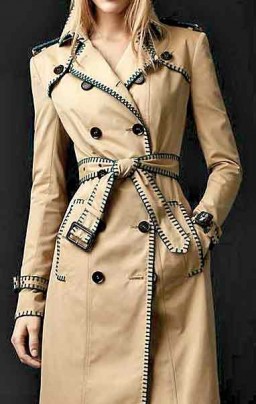 Traditionally used as a finishing stitch to envelop the raw edges of the hemlines, the blanket stitch is often used to trim the sides of a blanket and hence got its name as the blanket stitch, but is now innovatively worked on as a design element, also to patch or as an appliqué technique, to decorate the edge of a crocheted item or to protect the edges of fabric to prevent unravelling and fraying, used for decorative edging on usually surging edges of blankets, sweaters, polar fleece, and other linens.
Traditionally used as a finishing stitch to envelop the raw edges of the hemlines, the blanket stitch is often used to trim the sides of a blanket and hence got its name as the blanket stitch, but is now innovatively worked on as a design element, also to patch or as an appliqué technique, to decorate the edge of a crocheted item or to protect the edges of fabric to prevent unravelling and fraying, used for decorative edging on usually surging edges of blankets, sweaters, polar fleece, and other linens.
[/tab]
[tab title=”Fringing”]
 Fringing is sewing a decorative border or edging of hanging threads, cords, or strips, on the carpets or bed linen. Fringes can either be made via a machine or it can be an ornamental textile trim applied to an edge of an item. More commonly it is made separately and sewn on, consisting sometimes of projecting ends, twisted or plaited together, and sometimes of loose threads of wool, silk, or linen, or narrow strips of leather. [/tab]
Fringing is sewing a decorative border or edging of hanging threads, cords, or strips, on the carpets or bed linen. Fringes can either be made via a machine or it can be an ornamental textile trim applied to an edge of an item. More commonly it is made separately and sewn on, consisting sometimes of projecting ends, twisted or plaited together, and sometimes of loose threads of wool, silk, or linen, or narrow strips of leather. [/tab]
[tab title=”Satin Stitch”]
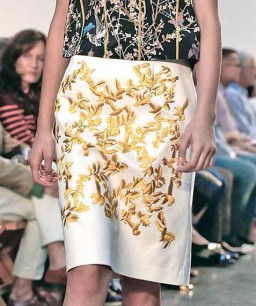 The most prominent of all, satin stitch is widely used for filling a particular motif, or for embroidery like look. Beautifully used as a finishing stitch to cover up the edges seamlessly, the stitch is more or less utilized to conceal the seams with perfection neatly.[/tab]
The most prominent of all, satin stitch is widely used for filling a particular motif, or for embroidery like look. Beautifully used as a finishing stitch to cover up the edges seamlessly, the stitch is more or less utilized to conceal the seams with perfection neatly.[/tab]
[tab title=”Overedge Stitches”]
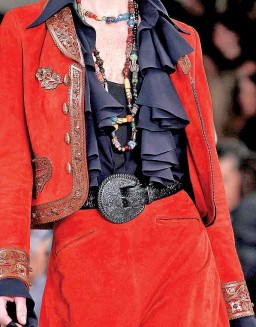 Overedge stitches are purposed as finishing stitches to enwrap the unclean edges on the hem, collars, cuffs, etc. Use of fancy or contrasting thread enhances the look of the design element. There are two types of decorative over-edge stitch formation.
Overedge stitches are purposed as finishing stitches to enwrap the unclean edges on the hem, collars, cuffs, etc. Use of fancy or contrasting thread enhances the look of the design element. There are two types of decorative over-edge stitch formation.
[/tab]
[tab title=”Fagoting & Picoetta Stitch”]
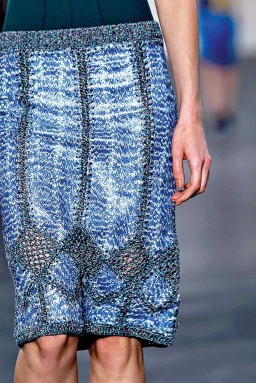 Intended to attach two separate pieces of fabric, creating drawn thread spacing, fagoting is a form of a decorative chain stitch innovatively incorporated on belts, collars, cuffs and sleeves, hemlines and as a design element on yokes.
Intended to attach two separate pieces of fabric, creating drawn thread spacing, fagoting is a form of a decorative chain stitch innovatively incorporated on belts, collars, cuffs and sleeves, hemlines and as a design element on yokes.
[/tab]
[tab title=”Fly or Feather Stitch “]
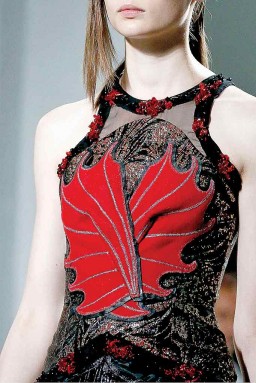 Resembling the shape of a flying bird like a ‘V’, the fly stitch and its variations are seen in garments, on hemlines, collars, cuffs and yokes. Similarly, the ‘Y’ shaped feather stitch, in the closed as well as the closed variation, worked on as a design element too.
Resembling the shape of a flying bird like a ‘V’, the fly stitch and its variations are seen in garments, on hemlines, collars, cuffs and yokes. Similarly, the ‘Y’ shaped feather stitch, in the closed as well as the closed variation, worked on as a design element too.
[/tab]
[/tabs_container]

